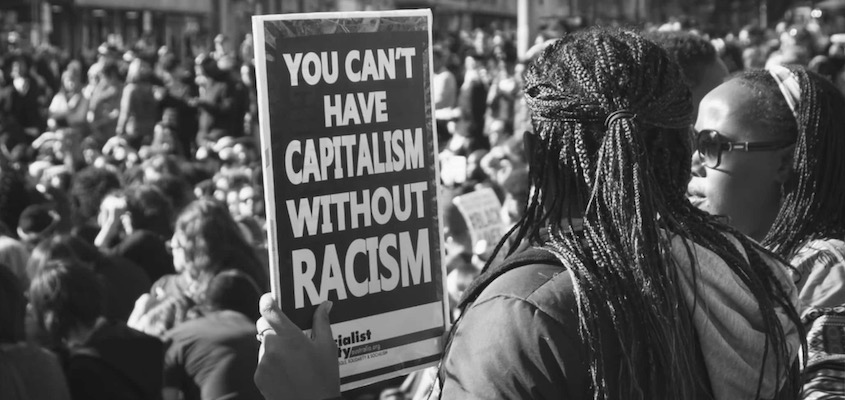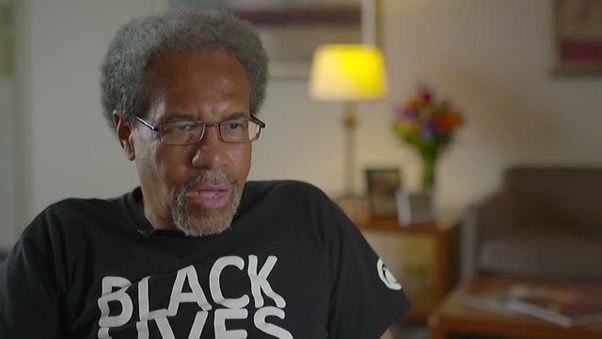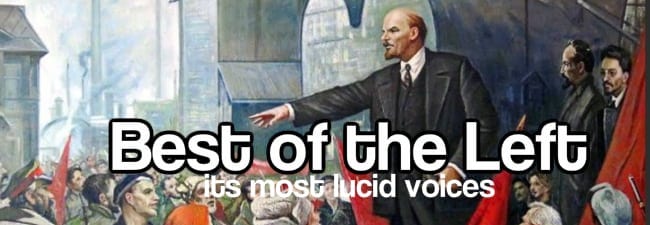From Black Wall Street to Black Capitalism
Contrary to the Black capitalist myth, most Greenwood residents were low wage working people employed by whites and living in substandard housing. It was the super-exploitation of poor Black labor that facilitated both the function of Tulsa as a whole and the Black Wall Street District. “As word of what some would later call the “Negro uprising” began to spread across the white community, groups of armed whites began to gather at hastily-arranged meeting places, to discuss what to do next.” -- Tulsa Race Riot: A Report by the Oklahoma Commission to Study the Tulsa Race Riot of 1921
“For far too long, Black liberal, you have been allowed to domesticate Black radicalism. Because our oppressors prefer you to us and at any sign of trouble, rush out to find you to speak on behalf of all Black people, you have eagerly taken the chance to hog all of the mics and silence us. You weaken our revolt with your narration.” --Yannick Giovanni Marshall, Black liberal, your time is up . Black capitalism is still capitalism.” – Terrell
Intro
The Tulsa Massacre began 100 years ago on May 31st, 1921 when an angry white mob accused a 19-year-old Black man, Dick Rowland, of raping a 17-year-old white girl, Sarah Page. Flustered by the perceived “Negro Uprising ” of Black men armed to defend and protect Dick Rowland outside the Tulsa courthouse, the inflamed white mob, sanctioned by the state, responded with brute terror, burning down the Black segregated neighborhood of Greenwood destroying 1,256 homes, nearly 191 Black businesses and the killing roughly 300 (likely more ) people by the morning of June 1st, 1921.
One hundred years since these 16 hours of white barbarism occurred, suppressive forces have steadily worked to delete this tragedy from scribing its crimson pages into the books of American history. But, as history shows, bloodstains prove difficult to remove. Recently, decorating over these stains as “blemishes” of an otherwise promising American Dream towards Black capitalism has proven to be a more sufficient means to quell dissent. What has materialized is an emphasis on what was destroyed over who was destroyed. Effectively, redeeming the state — the combined authority of government (elected), the bureaucracies (positions), corporate control, and private interests — in the process.
Decorating a Utopia that never was
As the summer of 2020 was steaming from protests against continued racialized state violence, the attention economy suddenly rediscovered the blood of 1921 by pivoting to what Booker T. Washington reportedly called “Negro Wall Street” or what is now known as Black Wall Street — the historic Black business district of the segregated Greenwood neighborhood destroyed in the massacre. According to Google Trends , the term “Black Wall Street” was googled more in June of 2020 than within the last 5 years.
Posited within 3-4 Blocks of the Greenwood neighborhood, this business district, disparagingly referred to by Tulsa whites as “Little Africa ,” was the home to a number of Black-owned enterprises including a fifty-four room hotel, a public library, two newspapers, a seven-hundred, and fifty seat theater, multiple cleaners, and two dozen grocery stores among more. Through these efforts, Black Wall Street produced a prosperous Black business class fancying “some of the city’s more elegant homes” and successful Black businesses in the state.
Faced with only these facts, it’s understandable why one would view Black Wall Street as a wealthy “self-sustaining” utopia violently interrupted by a white vigilante mob as it’s widely reported to have been. However, a much more complicated narrative scrubbed from decorated legend lies underneath the folklore of a Black American Wakanda.
Although Black Wall Street certainly brought pride to the Black residents of Greenwood, that pride failed to translate to a prosperous economic status for most. A report by the American Association of Social Workers on the living conditions of Black folks in Tulsa at the time stated, “95 percent of the Negro residents in the Black belt lived in poorly constructed frame houses, without conveniences, and on streets which were unpaved and on which the drainage was all surface.” Furthermore, most Greenwood residents were not only living in substandard housing but were employed outside of Black Wall Street according to the Oklahoma Commission study on the Tulsa Race Riot:
“Despite the growing fame of its commercial district, the vast majority of Greenwood’s adults were neither businessmen nor businesswomen but worked long hours, under trying conditions, for white employers [emphasis added]. Largely barred from employment in both the oil industry and from most of Tulsa’s manufacturing facilities, these men and women toiled at difficult, often dirty, and generally menial jobs — the kinds that most whites consider beneath them—as janitors and ditch-diggers, dishwashers, and maids, porters and day laborers, domestics and service workers. Unsung and largely forgotten, it was, nevertheless, their paychecks that built Greenwood, and their hard work that helped to build Tulsa.” [Emphasis added].
“The vast majority of Greenwood’s adults were neither businessmen nor businesswomen.”
Truthfully, as the report makes clear, Tulsa and Black Wall Street were both consequences of de jure segregation. Segregation operated as a public policy purposely made to suppress Black wages for the benefit of white capital while simultaneously limiting where those suppressed wages could be spent — inadvertently creating a monopoly for a petite Black professional class. Put differently, it was the super-exploitation of poor Black labor that facilitated both the function of Tulsa as a whole and the Black Wall Street District. Neither could have existed without the presence of poor Black people. Yet, their presence is rarely acknowledged in the revisionist plot. The suffering of the Black poor typically only matters when it can be used to bolster the class position of the Black Elite — the appointed political, cultural, and social representative and a moneyed class of Black people — and reinforce the state.
Decorating Blackness
As previously indicated, last summer, while police precincts became bonfires illustriously lighting up the night sky, the terms “Black Wall Street ” and “Black business ” were receiving more Google searches than ever before. The presuppositions of the searches call for questioning: Will a world on fire be resolved by the memory of a business district burnt down by a white mob? What is the correlation between a cop kneecapping a poor Black man’s neck and buying Black? How can I buy my way out of a chokehold? Do corporate pledges to “support Black business” deflect the oncoming bullets of State violence?
All Black people are subject to a degree of state violence but in today’s post-civil rights era, those flung to the bottom of the capitalist ladder (George Floyd) experience the worst fate — police murders, stop and frisk, incarceration, poverty, homelessness, and worse. In essence, LeBron James’ sons could not be Kalief Browder because not only can LeBron afford to bail his sons out of jail but Brentwood, California is far from the overpoliced neighborhood Browder was originally profiled in. Despite her same race and gender, Oprah is not Breonna Taylor. No knock warrants are unheard of in Montecito, CA, and gentrification does not work in reverse.
The point here is not to diminish the racism experienced by the Black Elite but to challenge the universalizing of Blackness. Universalizing Blackness as a flat experience allows Amazon to proclaim #BlackLivesMatter , create a Black-owned business page but crush the unions organized by its Black workers. It allows the NBA to paint BLM on its hardwoods, highlight Black business during the NBA finals but pay its predominantly Black and temp workers dirt wages. Universalizing Blackness distorts Blackness itself. It is decorating at its worst.]”
“How can I buy my way out of a chokehold?”
A repercussion of universalizing Blackness is elite capture — what philosopher Olúfẹ́mi O. Táíwò defines as “how political projects can be hijacked—in principle or effect—by the well-positioned and resourced.” This begins to explain how a radical demand such as abolishing the police either becomes dismissed or co-opted while the state offers its full cosmetic support behind Black business and representation. The class of Black people most well-positioned to make demands upon the state is better situated to benefit from Black business creation and corporate diversity hires than police abolition or the unionization of Amazon. They are considerably less afflicted by the problems of the people they claim to represent.
Universalizing Blackness collapses the interests of Black people as if we’re all equally invested in the same solutions. It’s precisely how the knees of killer cops on Black necks correlate with buying Black because as Táíwò notes, “When elites run the show, the ‘group’s’ interests get whittled down to what they have in common with those at the top.” It’s how the poverty of Greenwood ceases to appear in documentaries or presidential speeches when the Black wealth of a few needs attention. Commenting on sociologist E. Franklin Frazier’s groundbreaking 1954 text The Black Bourgeoisie , Táíwò observes how two seemingly opposing ideas continue to find continuity, “Why did the myth of a Black economy as a comprehensive response to anti-Black racism survive when it was never a serious possibility? In Frazier’s telling, it did because it furthered the class interests of the Black bourgeoisie.” The class interests remain.
Black Capitalism, the Ultimate Decoration
The elite capture of a movement requires a series of decorative myths — ideas that obscure the nature of the problem for the maintenance of the status quo. Last summer Black capitalism emerged once again as the most decorated myth. The revisionism of Black Wall Street, as an extension of Black capitalism, neatly fits the narrative of universal Blackness. It utilizes the universality of a tragedy suffered by an entire Black population to advocate for a solution (Black capitalism) that has shown to primarily benefit a particular class of Black people.
Black capitalism is a concatenation of propaganda. It relies on complementary myths such as Black buying power and Black dollar circulation that are premised upon shaming Black people, particularly the poor ones, for their alleged frivolous spending. Besides the fact that Black people spend their money no more recklessly than anyone else, Black capitalism feeds on stereotypes of broke Black people foolishly buying Jordans and weaves they cannot afford to justify its existence. The saying typically goes “if we spend with our own then we can have our own” as if Black people’s spending habits are moral barometers.
This decorative myth is exemplified in the creation of the Greenwood banking app. Popularized by rapper Killer Mike and actor Jesse Williams this app is “inspired by the early 1900’s Greenwood District, where recirculation of Black wealth occurred all day, every day, and where Black businesses thrived.” The website , littered with unsubstantiated claims of Black dollar circulation, conveniently fails to discuss the rampant Black poverty in the “1900’s Greenwood District” they claim to want to recreate. To highlight such a contradiction would ruin their business model.
Businesses such as “Greenwood” use the history of how collective Black wealth has been systematically destroyed by capitalism to leverage (guilt) white investors for funding. In the case of Greenwood, receiving 40 million dollars from banking institutions including JP Morgan Chase, Bank of America, and Trust among others. The billions of corporate dollars injected into “racial equity ” campaigns this last year were all sparked by the militant response to the blatant murder of a poor Black man who was allegedly arrested for purchasing items with a counterfeit bill. Disturbingly, the death of poor Black people is a lucrative fundraising drive for everybody but the ones experiencing death.
Decorating an Empire
What rests at the heart of these issues is the Black Elite’s general unwillingness to confront the state and all the violence it subsumes. As a class, they are much more invested in collaborating — either for perceived survival and/or personal gain. What tends to go unsaid is that when they collaborate with the state they often lose even on their terms. The police still confuse them for poor “thugs .” They remain underrepresented and underpaid in their respective fields. Laws that sustain their lifestyle are constantly eroded . Yet, historically, they have made the most “progress” in periods where the masses of Black people dissented. Due to their economic instability, they are unable to exist as a class by themselves — hence the need for the symbolic support of the masses analogous to how Black Wall Street needed the paychecks of the Black poor to thrive as a business district.
The state uses these decorators of empire, knowingly or not, to maintain its legitimacy. White supremacy may have obliterated Black Wall Street — 1st through violence, 2nd through policy — nevertheless “if that massacre never happened who knows how that shapes America today .” The bloodshed of the past is decorated by the false promise of “a more perfect union.” Organizing for a world beyond American hegemony is scolded as unrealistic and sophomoric. The most moderate of Black radical demands such as “defund the police” are derided and blamed unfairly for costing congressional seats as if Democratic party success is synonymous with Black liberation.
“Black Wall Street needed the paychecks of the Black poor to thrive as a business district.”
Decorators of empire must corral dissent. This type of agency reduction has a footprint leaping back to the Cold War and much further. Dr. Charisse Burden-Stelly, assistant professor of Africana Studies and Political Science at Carleton College, thoroughly documents how the Black Elite of the time — Black Cold War liberals — “reduced the collective agency of other African Americans by marginalizing or maligning the panoply of liberation strategies emanating from the Black left.” This was a necessary strategy because the Black Cold War Liberals “formed important relationships with powerful Whites to procure goods and services for the Black community while offering no challenge to exploitative economic and social relations.” Modes of thinking outside of these brokered relationships threatened to bring backlash from the state. Faced with the mounting repression of the anti-communist McCarthy era, “…Black Cold War liberals began to distinguish themselves from the left by rejecting militant agendas that might align them with those deemed ‘communist fronts,’ including the Council on African Affairs (CAA), the Peace Information Center (PIC), and the National Negro Labor Council. Black Cold War liberals signaled such rejection by casting their platform in anti-communist terms and by constructing Black people as loyal, trustworthy Americans who deserved to be recognized as full citizens.”
Consistent with elite capture, Black Cold War liberals corralled the ideologies of the Black masses. “Seditious” communist ideas and “backward” social behavior would not earn the acceptance of the state. Irrespective of the oppression they faced, Black people of the time were corralled to focus their aspirations on proving to the state they were just as American as everyone else.
Today, building on a similar logic, Black American suffering is promoted as a badge of honor — a “justice claim” made because “we built this country.” Black people are “the Soul of the Nation ” who “saved American democracy.” Again, the bloodshed of the past is used to redeem the present. President Biden, in his speech for the 100th anniversary of the Tulsa Massacre, leveraged this Black American exceptionalism to bolster the empire: “We should know the good, the bad, everything. That is what great nations do. They come to terms. With their dark side. We are a great nation.” Only in America can a nation be “great” for acknowledging a single massacre 100 years later with no reparations to show — decorating at its finest.
Conclusion
Remembering the Tulsa Massacre not as a violent white response to Black self-defense and determination but instead as the destruction of property and mythical Black wealth favorably leaves space for American redemption. It reduces the violence to a tragic interruption of the American dream and Black capitalism while minimizing other race massacres that did not include a well of black business class.
Wall Street is a parasitic model we should not emulate — still, I empathize with Black people’s desire for Black ownership and self-determination. There’s nothing inherently wrong with this desire. However, positioning slogans like #BuyBlack and #SupportBlackBusinness as the respectable alternative to radical transformative demands is decorating for the state — particularly when these slogans are attached to faulty concepts like trickle-down economics and universal Blackness. Black ownership is elite capture without the correct redistribution and collective ownership of the wealth we create.
Lastly, it need not be stated that the victims of the Tulsa Massacre — as well as their descendants and all African people — deserve their reparations. That is not in question. We should question the state’s legitimacy to define our collective goals. We must be vigilant towards the state’s attempts to use the atrocities committed against us as a means to redeem itself by decorating its crimes. The world we deserve is irreducible to a Black Wall Street and abundantly superior to anything America currently has to offer. It’s on us and those in solidarity to fight for it.
This article previously appeared in Hood Communist.
Addendum
The Tulsa massacre as commemorated by liberals
COMMENTS?
Please join the conversation on Black Agenda Report's Facebook page at http://facebook.com/blackagendareport
Or, you can comment by emailing us at comments@blackagendareport.com
If you find the above useful, pass it on! Become an "influence multiplier"!
The battle against the Big Lie killing the world will not be won by you just reading this article. It will be won when you pass it on to at least 2 other people, requesting they do the same.
| Did you sign up yet for our FREE bulletin? It's super easy! Sign up to receive our FREE bulletin. Get TGP selections in your mailbox. No obligation of any kind. All addresses secure and never sold or commercialised. [newsletter_form] |
![]()
This work is licensed under a Creative Commons Attribution-NonCommercial 4.0 International License

















